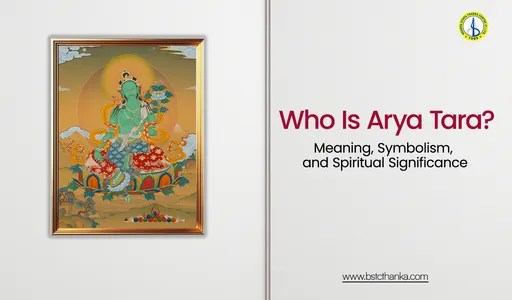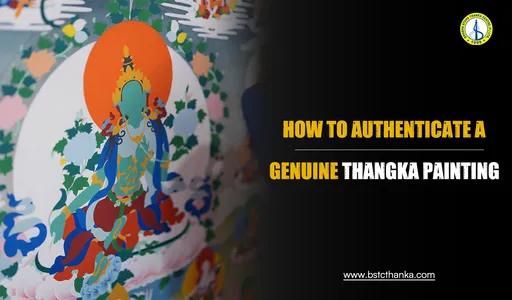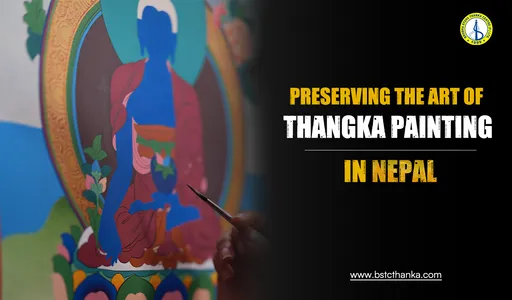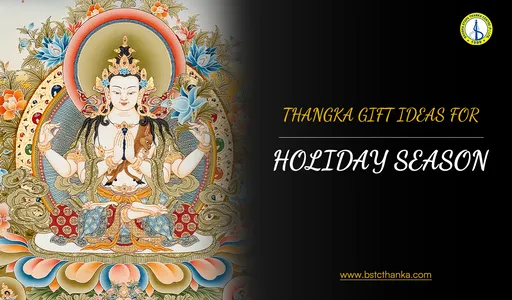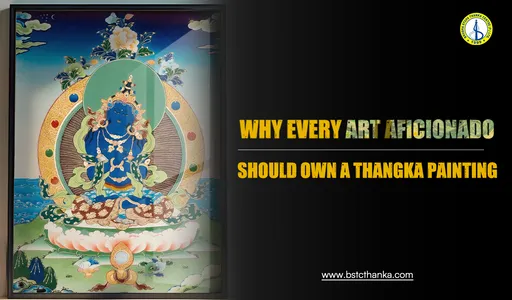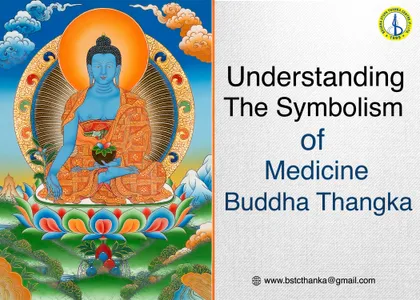The Role of Thangka Painting in Buddhism
Thangka painting is a form of traditional Tibetan Buddhist art that has been practiced for centuries. These paintings are highly detailed, and colorful, and often depict deities, spiritual symbols, and important scenes from Buddhist teachings. Thangka paintings are not just works of art, but they also serve an important role in Buddhist practice and meditation. In this article, we will explore the role of Thangka painting in Buddhism and how it helps practitioners deepen their understanding and connection to the teachings.
Thangka paintings are more than just decorative objects; they are considered sacred objects that are imbued with spiritual power. Thangka paintings are typically created on cotton or silk canvas and are made using natural pigments. The process of creating a Thangka painting is highly ritualized and involves strict adherence to traditional techniques and materials. The artist will typically begin by sketching the design onto the canvas using charcoal and then will fill in the details using a variety of techniques, such as brushwork, stippling, and shading.
One of the primary purposes of Thangka paintings is to aid in visualization meditation. Visualization meditation is a form of Buddhist practice that involves creating a mental image of a particular deity or spiritual symbol. The Thangka painting serves as a visual aid to help the practitioner create a clear mental image of the deity or symbol. The painting serves as a guide for the practitioner, helping them to focus their attention and cultivate a deeper connection with the teachings.
In addition to aiding in visualization meditation, Thangka paintings also serve as a tool for teaching the dharma, or Buddhist teachings. The paintings often depict important scenes from Buddhist texts and teachings, such as the life of the Buddha, the Bodhisattvas, and the various deities and spiritual symbols. These paintings are often used in temples and monasteries to help teach the dharma to both monks and lay practitioners.
Thangka paintings also serve as a means of expressing devotion and gratitude to the deities and spiritual figures depicted in the paintings. Buddhists believe that the deities and spiritual figures depicted in Thangka paintings possess spiritual power and can help practitioners on their spiritual journey. By creating and displaying Thangka paintings, Buddhists express their devotion and gratitude to these figures and seek their blessings and guidance.
Another important role of Thangka paintings in Buddhism is to preserve the teachings and traditions of the religion. Thangka paintings are often passed down through generations of practitioners and are seen as a way to preserve the knowledge and wisdom of the tradition. In this way, Thangka paintings serve as a link between the past and present, connecting practitioners to the teachings of their ancestors.
Thangka paintings are also a form of offering to the Buddhas, Bodhisattvas, and other spiritual figures depicted in the paintings. Buddhists believe that making offerings is a way to accumulate merit and purify negative karma, thereby enhancing their spiritual practice and progress on the journey.
Thangka paintings are not just limited to traditional Buddhist themes and symbols; they can also be used to depict contemporary themes and issues. Modern Thangka artists often create paintings that address current social and environmental issues, such as climate change, human rights, and gender equality. By using the traditional techniques and materials of Thangka painting to address contemporary issues, these artists are both preserving the tradition and using it to create new and relevant works of art.
In conclusion, Thangka painting plays a vital role in Buddhism. These paintings serve as visual aids for meditation, teaching tools for the dharma, expressions of devotion and gratitude, links to the past, offerings to the deities and spiritual figures, and even as a means of addressing contemporary issues. Thangka painting is a unique form of art that is deeply rooted in Buddhist philosophy and practice, and its importance cannot be overstated. Through the centuries, Thangka painting has evolved into a highly refined art form, with a rich history and cultural significance.
In addition to its spiritual and religious significance, Thangka painting has also gained popularity among art collectors and enthusiasts around the world. The intricate details, vibrant colors, and deep symbolism of Thangka paintings make them highly sought after by art collectors and museums alike. In recent years, the Thangka painting has also gained recognition as an important cultural heritage of Tibet and is protected by UNESCO.
Thangka painting is not just limited to Tibet and the Tibetan Buddhist tradition; it has also spread to other countries and Buddhist traditions, such as Nepal, Bhutan, Mongolia, and many more. Each tradition has its own unique style and techniques, but all share the same underlying philosophy and purpose.
Despite its popularity and cultural significance, Thangka painting is facing challenges in the modern world. The traditional techniques and materials used in Thangka painting are becoming increasingly rare and expensive, and the younger generation of artists is showing less interest in pursuing this art form.
To address these challenges, efforts are being made to preserve and promote the traditional techniques and materials of Thangka painting. Traditional artists are passing down their knowledge and skills to the next generation, and new artists are being encouraged to learn the art form. Organizations and initiatives are also being established to promote and protect the cultural heritage of Thangka painting.
Some popular Thangka paintings
1) Mandala Thangka:
Mandala thangkas are intricate and colorful representations of the Buddhist concept of the universe and cosmos. They are a type of traditional Tibetan Buddhist art that originated in the Himalayan region and are considered to be a form of meditation and spiritual practice.
A thangka is a painted or embroidered piece of cloth that is usually hung in a monastery or a household as a devotional object. The word "thangka" comes from the Tibetan word "thang" which means "flat" and "ka" which means "painting." A mandala, on the other hand, is a Sanskrit word that means "circle." It is a geometric pattern that represents the cosmos and the spiritual journey toward enlightenment.
Mandala thangkas are a combination of both thangka and mandala, and they depict various deities and symbols that are significant in Tibetan Buddhism. These thangkas are often used as a focus point during meditation and are believed to help practitioners in their spiritual journey toward enlightenment.
The creation of a mandala thangka is a complex and time-consuming process that requires skilled artists who have been trained in traditional Tibetan Buddhist art. The artists use natural pigments and dyes to create intricate designs, which are often painted on cotton or silk canvas.
The design of a mandala thangka usually starts with a circle, which represents the universe. The center of the mandala is usually occupied by a deity or symbol that represents enlightenment, while the outer circles depict other deities, symbols, and other aspects of the universe. Furthermore, the other two significant thangkas include Kalachakra Mandala and the Universal mandala.
Mandala thangkas are not just beautiful pieces of art but also serve as spiritual tool for Tibetan Buddhists. They are believed to have a transformative effect on the viewer, helping them to connect with the spiritual world and to gain insight into their own spiritual journey.
2) Medicine Buddha Thangka:
This painting depicts the Medicine Buddha, who is believed to have the power to heal physical and mental illnesses. The Medicine Buddha is often depicted in blue color and is surrounded by other Buddhist deities and symbols.
3) Green Tara Thangka:
Green Tara is a female Bodhisattva who is believed to have the power to grant wishes and protect from fears and dangers. The Green Tara Thangka is often depicted in green color and is surrounded by other Buddhist deities and symbols.
4) Wheel of Life Thangka:
The painting depicts the cycle of birth, death, and rebirth, and the various realms of existence in Buddhist cosmology. The Wheel of Life Thangka is often used as a teaching tool to explain Buddhist philosophy.
5) Guru Rinpoche Thangka:
This painting depicts Guru Rinpoche, also known as Padmasambhava, who is considered the second Buddha in Tibetan Buddhism. According to Tibetan Buddhism's portrayal of Guru Rinpoche through artistry showcases him attired in scarlet robes which has come to symbolize him oftentimes as well. Regardless of this association with a particular hue though what remains significant about this deity's representation is that he personifies enlightenment without being confined only to a single physical appearance or shade spectrum.
This sentiment can be seen when observing illustrations where diverse colored garbs like those colored yellow or blue have been used as well. Ultimately, it is the teachings and wisdom of Guru Rinpoche that hold the utmost importance reflecting his embodiment of enlightenment.
Thangka painting is not only a form of art but also a way to connect with the teachings and traditions of Buddhism. Each Thangka painting is unique and holds deep spiritual significance for practitioners of the religion. Through the centuries, Thangka painting has been a valuable tool for meditation, teaching, and devotion, and continues to be an important part of the cultural heritage of Tibet and other Buddhist traditions.
Materials and Techniques Used in Thangka Painting
Thangka paintings are made using a variety of materials and techniques that have been developed over centuries. The process of making a Thangka painting is intricate and requires a high level of skill and attention to detail. Here are some of the materials and techniques used in Thangka painting:
Canvas: Traditionally, Thangka paintings were made on cotton or silk canvas. The canvas was first prepared with a mixture of glue and chalk powder to create a smooth surface.
Pigments: Natural pigments made from minerals, plants, and other materials are used to create the colors in Thangka paintings. The pigments are ground into a fine powder and mixed with water and glue to create a paste.
Gold: Gold is often used to highlight certain areas of the Thangka painting, such as the faces of the deities or the borders of the painting. Gold is applied using a special technique known as gold leafing.
Brushes: Brushes made from animal hair, such as goat or squirrel, are used to apply the pigments to the canvas. Different brushes are used for different areas of the painting, depending on the size and level of detail required.
Outlining: A special black pigment made from soot is used to outline the figures and other elements of the painting. The outlines are first drawn with a pencil or charcoal and then filled in with black pigment.
Finishing: Once the painting is complete, it is covered with a layer of varnish to protect it from damage and to enhance the colors.
The process of making a Thangka painting can take several weeks or even months, depending on the size and level of detail required. Traditional Thangka painters undergo years of training to master the techniques and skills required to create these intricate works of art.
Thangka paintings are used in various ways to aid in meditation, prayer, and spiritual practice in Buddhism.
Here are some of the ways in which Thangka paintings are used:
Visual Aid for Meditation: Thangka paintings are often used as visual aids for meditation. Practitioners use the paintings to focus their attention and visualization on a specific deity or aspect of Buddhist philosophy. The intricate details and colors in the painting help to create a conducive environment for meditation and the imagery is believed to help the practitioner connect with the divine
Altar Decoration: Thangka paintings are often hung on altars in temples, monasteries, and homes. The paintings serve as a visual reminder of the teachings and traditions of Buddhism and help to create a sacred space for prayer and contemplation. The presence of a Thangka painting on an altar also symbolizes the presence of the deity or aspect of Buddhism depicted in the painting.
Teaching Tool: Thangka paintings are often used as teaching tools to explain the various aspects of Buddhist philosophy, cosmology, and deities. The intricate details and symbolism in the painting help to convey complex ideas in an easily understandable way. Thangka paintings are used by Buddhist teachers to explain the principles of the religion to their students and to aid in their understanding of the teachings.
Devotion: Thangka paintings are used as a way to express devotion and respect to the deities and aspects of Buddhism depicted in the painting. Practitioners offer prayers, incense, and other offerings to the deities depicted in the painting as a way to show their reverence and gratitude. The act of offering is believed to create a positive karmic connection between the practitioner and the deity.
Empowerment: Thangka paintings are also used in empowerment ceremonies, where a practitioner receives blessings and empowerment from a teacher or master. The teacher will use a Thangka painting to transmit the blessings and empowerments to the practitioner, and the practitioner will visualize themselves receiving the blessings from the deity depicted in the painting.a
Overall, Thangka paintings play a crucial role in meditation, prayer, and spiritual practice in Buddhism. They are not just works of art, but also serve as powerful tools for connecting with the divine and deepening one's understanding of Buddhist philosophy and teachings.
Thangka paintings are known for their intricate details and vivid colors, which are used to depict various deities, symbols, and scenes from Buddhist cosmology and philosophy. These images are steeped in symbolism and carry deep meaning for practitioners of Buddhism.
Here are some of the common symbols and meanings found in Thangka paintings:
Buddhas and Bodhisattvas: The central figures in many Thangka paintings are Buddhas and Bodhisattvas, who are revered as enlightened beings who have achieved spiritual liberation. The various poses and hand gestures of these figures, known as mudras, represent different aspects of Buddhist philosophy, such as compassion, wisdom, and the overcoming of suffering.
Mandalas: Mandalas are complex geometric designs that represent the universe and the various realms of existence in Buddhist cosmology. Mandalas are often used in meditation and are believed to aid in the attainment of enlightenment.
Animals: Various animals are depicted in Thangka paintings, each of which carries its own symbolic meaning. For example, the lion represents strength and fearlessness, while the peacock represents beauty and purity.
Colors: The colors used in Thangka paintings also carry symbolic meaning. For example, blue represents compassion and wisdom, while red represents power and passion.
Elements: Elements such as fire, water, earth, and air are often depicted in Thangka paintings, representing the various aspects of nature and the universe.
Lotus Flower: The lotus flower is a common symbol in Thangka paintings, representing the purity of the mind and the attainment of enlightenment. The lotus flower is often depicted with various deities and represents their ability to overcome suffering and achieve spiritual liberation.
Eight Auspicious Symbols: The Eight Auspicious Symbols, also known as the Eight Treasures, are a set of symbols that represent different aspects of Buddhist philosophy. These symbols include the wheel, the lotus, the parasol, the vase, the conch shell, the banner, the fish, and the endless knot.
Overall, Thangka paintings are rich in symbolism and meaning, and the images depicted in these paintings serve as a visual representation of Buddhist philosophy and teachings. The intricate details and vivid colors of the paintings help to convey complex ideas in an easily understandable way and aid practitioners in their meditation, prayer, and spiritual practice.




